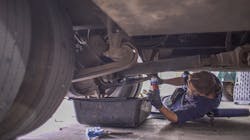This is part two of a two-part article. Check out part one here.
Preventive maintenance, especially when it's successful, is rarely the most exciting part of a technician's job. But completing the repetitive task of scheduling PM intervals is still critical to keeping assets on the road. The first part of this series discussed tools shops can use to better measure and coordinate their various preventative maintenance appoints, as well as some options for allocating precious technician labor hours to the task. But PMs can provide as many spinning plates on the managerial side as on the shop floor to ensure that these routine jobs do not detract from overall efficiency for both technicians and drivers.
Managing complexity
On the supervisory level, the issue is coordinating all the complexity. Their ultimate goal is to optimize PMs and repairs to make the most out of the time and equipment in the shop. But even when certain services, such as a DOT inspection, work well with a scheduled PM, they can add complexity by uncovering more unplanned work that needs to be addressed.
Dave Walters, sales support engineer for Trimble Transportation, said annual DOT inspections and repairing associated defects can be difficult to manage, as they are required and must be done in a specific time frame to avoid noncompliance.
Read more: Focusing on preventive maintenance to maximize uptime“Annual DOT inspections are more comprehensive and complex, and, as a result, may uncover additional work that needs to be done,” he said. “They often take longer to complete than a quick ‘in and out’ repair.”
Daniel Mustafa, director of technical service for TravelCenters of America, added that DOT inspections also require a higher level of certification for the technician doing the work. TA’s system monitors techs who can complete DOT inspections and prevents them from logging into a work order if unqualified. “We might run into technician availability that would negatively affect completion time,” he said.
Warranty repairs, which need to be done by OEM-approved techs, can also add complexity when found during a PM, as scheduling dealer capacity can be tricky, Walters said.
Kirk Altrichter, EVP of fleet services for Kenan Advantage Group, said DPF filter cleanings take longer because shops have to coordinate not just removing the DPF but where they will get it cleaned and how long it will take to clean it.
“The objective is to keep the same filter with the same truck,” he said.
Findings from PM inspections can turn into larger jobs, which makes managing the throughput of the shop and meeting commitments a challenge, said Ben Johnson, director, product management, Mitchell 1.
Follow-up work also increases as equipment gets older. “As the vehicle ages and accumulates miles, the amount of follow-up work increases,” said Dan Carrano, VP of fleet maintenance for A. Duie Pyle. “You address the safety and reliability issues first—brake issues, power trains—versus a squeaky seat. The lesser priority issues may not get done at that time and you’ll schedule it in.”
As part of its PMs, A. Duie Pyle checks the DPF soot level and does a forced regen to burn it off if the soot is at a set level. “The goal is to help alleviate drivers doing a parked regen, and it has helped,” Carrano said.
Optimizing drivers’ time is one of Carrano’s top priorities. “If you do a thorough, comprehensive inspection and follow-up repairs, it will reduce the number of things a driver finds during a pre- and post-trip,” Carrano said. “If drivers find a lot of defects, it affects the amount of yard time and creates a lot of extra unproductive time.”
Read more: Preventive maintenance for commercial vehicle doors and locksFailures over the road can create significant delays for drivers and inconvenience for clients. “The quality of your PM program is extremely important to your profitability, your drivers’ satisfaction, and customer satisfaction,” said Kevin Clark, head of shop operations for Cox Automotive Mobility Fleet Services.
Increasing communication
To truly optimize scheduling, communication is critical among all the various departments. Jessica Kim, head of marketing for Pitstop, said technology can ensure accurate information is transmitted between the fleet and the shop.
“You’re counting on the fleet manager to communicate that vehicle’s needs to the shop,” she said. “They may not be getting the exact pieces that the fleet manager is getting from that vehicle.”
Fullbay has a customer portal that gives the end customer direct access to all maintenance records so they can review costs and analyze data. “There is an expectation now. If you want a relationship with a customer, you have to provide these analytics,” said Chris O’Brien, chief operating officer of Fullbay.
TA has an online platform that allows fleets to coordinate with locations directly. It also interacts with TA’s POS. “They can read service rider and technician comments and approve and deny work very quickly,” said Jason Richards, program manager II for TravelCenters of America.
Mustafa added that increasing transparency can help build trust. “We bring the customer into the process so they understand what is being done or not being done on their vehicle,” he said, adding that technicians can even take customers into the pit to show them the work.
Technology can also help shops manage other risks, such as credit card disputes, which O’Brien said are rising. “There is a lot of nefarious activity where truckers are crossing state lines, getting services at 3 a.m., using a credit card to pay, and then disputing the charge,” he said. “Depending on how that process is handled, shops can lose out. Do signature capture and get vital information from the trucker.”
O’Brien also recommended shops evaluate their terms of service.
“You write something that says ‘satisfaction guaranteed,’ and that can be your archnemesis,” he said. “Make it very clear that you’re providing your services and not that satisfaction is guaranteed or warranty is implied.”
